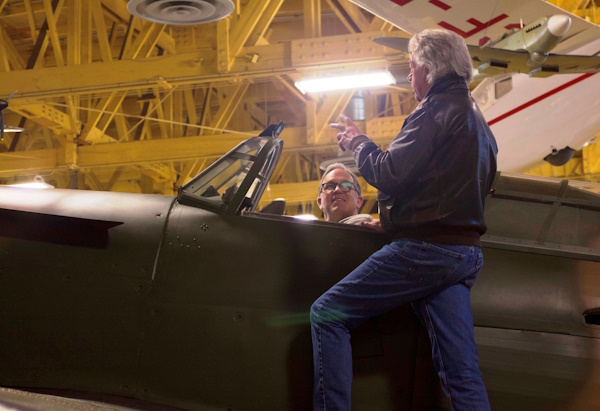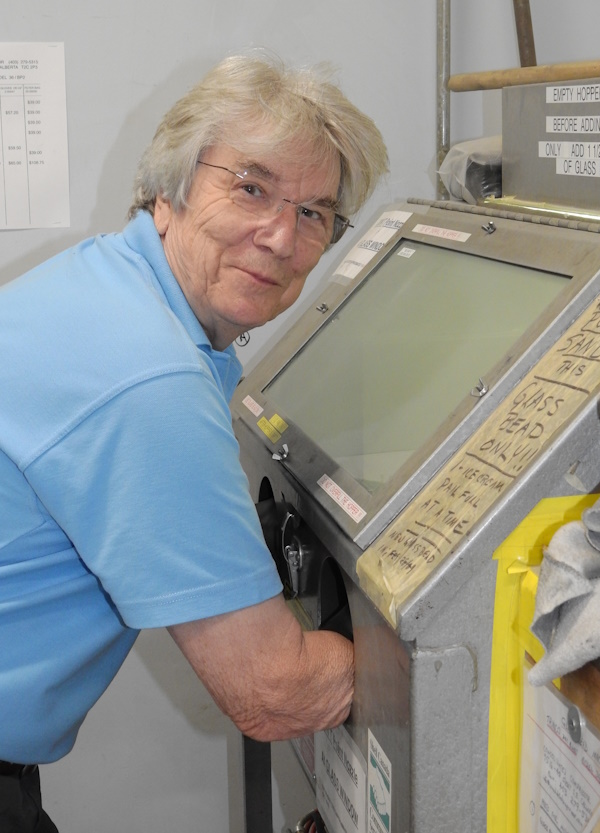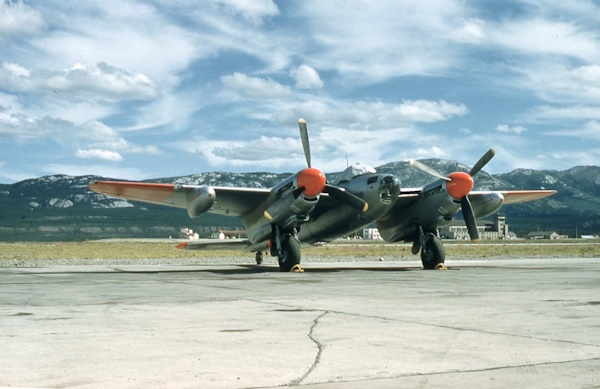
Click on any image for a slideshow!

The Calgary Mosquito Society's
Welcome to the Sweaty Season, Quarterly Report!
We've been busy with both of our beautiful birds over the past quarter. Lots of hours invested and lots of progress to show for it. Dive in for your latest Aero-Literary adventure!
Hurricane
The most significant news on the Hurricane engine front is that the test club prop finally arrived back from Western Propeller in Richmond, BC., albeit after 7 months and at two and a half times their original cost estimate... With that now in hand we have mounted the prop on the engine. It just remains to fill in the few missing bits and details on the coolant, electrical and oil systems on the test stand. Thanks to Davy D. for the pickup and delivery service on the prop.
Since we won't be changing the pitch on the club prop, we needed to plug the oil line that controls the pitch system, by inserting a custom built plug into the prop shaft, carved by our multi-talented Gary T. The plug has now been fitted with grub screws to hold it in place. Once we torque down the prop, we will use the last screw hole in the plug to lock it in place (as long as everything lines up).

After seven months, our club prop finally made it back from Western Propeller. At right, Dick S. manages the install process.
Note the unusually long exhaust stacks on the engine.
We are shy by one small part for the coolant system, though the vendor has assured us that is just days away. Once installed, we will put a few pounds of pressure on the system to determine if we have any leaks.
On the electrical frontier, we have ordered a couple of bus bars which will not be in for a few weeks. (Anyone remember how great the supply chain was prior to Covid? Sadly, those days are long gone).
We needed a set of exhaust pipes for the engine and given that the originals are currently attached to the airplane on display, we thought it best to 'borrow' a set from the Mosquito. For the rivet counters among us, it looks odd to have a set of long pipes on a Packard 29, but they will do the job.
We are also working on throttle and mixture controls to mount on the pedestal part of the test stand. Slow but steady. If all goes well, we anticipate turning it over on the battery by mid-July.
Mosquito
Though our volunteers put in 1659 hours on the Mosquito in this quarter, a significant percentage of those hours were actually spent working with and for our hosts at the Bomber Command Museum. When we moved into the shop area back in August 2012, there was a Cessna Crane project hanging from the ceiling over our work area. When the museum acquired a fully restored Crane, the ceiling dweller was up for grabs and a nice man from Saskatchewan recently bought it. The next issue was how to get it down, in light of the fact that we occupy all the floor space beneath it? For the past six months, there has been a lot of navel and ceiling gazing as we pondered the question while waiting for summer airplane moving season. Because our wing is secured in a jig which is affixed to the floor we can't move it, so it looked like we would have to somehow flip the Crane wing and lift it out, over top of our wing. Ick. The mind quickly goes to all manner of 'oops' possibilities.

Markus, Zac, Matthew and Joe work on emptying and removing the last shelf unit behind our wing and below the Crane. At right, cleaner than it's been in over a decade; all of the parts boxes, materials and shelving units removed so that the Crane can be lowered directly to the floor. You're welcome Bomber Command.
In the end, we settled on moving out all of our parts boxes and materials on the shelves all along the north wall beneath the Crane and then disassembling and moving the shelf units. That was a whole lot of work that occupied many volunteers over several Saturdays. Once completed, the space was clear for the Crane fuselage and wing to be lowered to the floor and scooted out the hangar door to be transported to its new home. That was accomplished in late June and of course once the Crane was down and out of the way, we reversed all of our efforts to rebuild the shelf units and put all of our boxes, parts and materials back where they were. In the process we were able to dispose of some 'no longer neededs' and reorganize some of our hard to find and keep track of parts. Big thanks to all of our Saturday volunteer crew who did the haulin' and sweatin'.

At top, dropping the Crane fuselage to the floor. Excellent work by the crew on the job. Below, the Crane outside, awaiting transport to its new home in Kindersley, SK. For us, it meant having to put all the shelves, boxes, materials and parts back.
Getting back to the Mosquito, things are moving forward in a number of ongoing areas.
We'll start with Gary T. and the 'Great Skin Replacement' project. Gary is making good progress on both the port and starboard ends of the wing with just four of the thirteen panels left to remove and replace. Of course being the highly skilled and willing sort that he is, Gary is often pulled from wing duty to help out in other areas.
Both Gary and Dick S. switch to other smaller tasks like building components for Don H. and Andy W. who need tubing holders for the inside of the fuselage. Gary and Dick also get into things like straightening leading edge and firewall components, riveting parts, working with firewall seals, or carving walnut bits for the guys working on the trailing edge of the wing. A commonly overheard phrase is "do you have a tool for making ...?" with a response of "yes, but back in Calgary..." which makes every little thing take just that much longer.
When he is not distracting Gary on Saturdays, Don H. continues to run parts to Top Gun Coatings through the week, which gives us a bunch of wing hardware and fittings for other volunteers to reinstall.
Gerry M. has found his way home from the deep south (Arizona) to pick up on the reinstallation of those wing parts. With new hardware to facilitate the reassembly, Michael H. and Gerry are building up the assemblies. Once these are reinstalled on the port wing, we will remove the mirror assemblies from the starboard wing and do it all again.
Nigel C. has basically completed cleaning the fuel tank bays, which puts us over the top of the hill and allows us to move ahead with new paint in the bays and soon thereafter, reinstallation of a million 'where did it go?' parts.
Cam B. has caught up with most of the small metal parts painting. These are parts such as the fuel bay stress panels and nut plates which are now ready to be reinstalled. The screws have been Teflon coated to protect the hardware as well as ensuring ease of installation.
The wing group will focus on completing fuel bay No.1 on the left outboard wing. On the upside, with bits and pieces going back together and getting installed, the number of parts crates onsite and in storage, is dropping noticeably.

Someone we've not seen for a while is Jordan F who started coming out on Saturdays when he was just eight years old. Now twenty, Jordan is scheduled to start his AME program at SAIT in January. At right, Zac M., now our youngest regular volunteer, works on a firewall to main spar bit.
Zac M. and Andrew S. have been working on upper wing to firewall components in the area of Gary's work. The component has been dismantled, cleaned by Zac, metal parts straightened by Dick, sent off to the welder for repairs, and then back for paint by Cam. One wood part needs replacement (walnut block) by Gary then it all goes back together. That's how many different people and diverse skills it takes, just to restore one component.
Jaime G. continues rebuilding the first main landing gear. Now that it is nearing completion we have begun work on the second main gear. Don H. has delivered more freshly silvered main landing gear parts from Top Gun while Joe M. has built a jig to assemble and hold the lower section of the landing gear assembly.
Andy W. and Don H. continue inside the fuselage, re-plumbing and building significant components for this project. Once we get all the Crane inspired reorganization out of the way, we will dig out one under wing side panel from offsite storage as Andy's lines from the front end of the fuselage will soon have to meet up with Don's work from the back end. As we have learned, all fluids, hydraulic, air and fuel run down the starboard under wing panel.
To aid this process Andy invested 85 hours at home and has just had printed a sizeable diagram showing how the hydraulic, pneumatic and various other lines run from the cockpit right to the end of the fuselage. Amazing work. Yea, detail loving engineers!
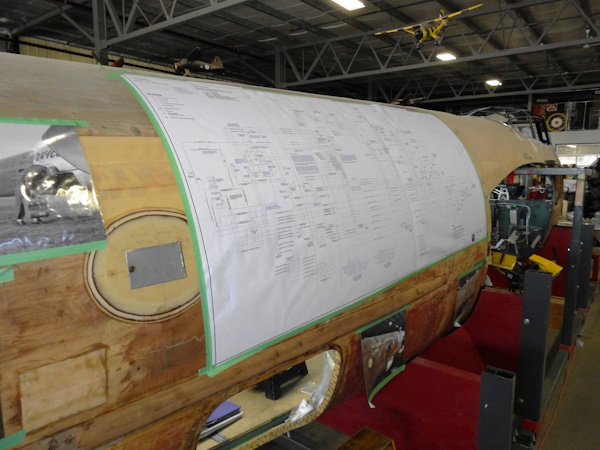
The Fuselage Services Flow Diagram. Andy W's at home work over the past couple of months.
Davey D. continues with his work on the firewalls, (yes, now plural) as the second one is now painted and ready for assembly. Cam B. has one firewall face left to paint before it goes over to the main assembly, which then brings us closer to being able to mate the firewall in the fixture with the undercarriage.

Restoration boss Jack M. working with Davey D. on some firewall details. Davey is often down at the museum through the week working on his own in addition to being a Saturday stalwart.
Events and Miscellaneous
Again we say 'thanks' to Richard Fox who heads the Mosquito project at the Canadian Aviation Museum in Windsor, for sending us a couple of handfuls of nut caps that we were unable to source. It's good to have friends and trading partners.
As usual, this quarter marks the start of event days at the Bomber Command Museum and us Mosquito types are usually involved in one way or another and are certainly kept busy on such days, hosting visitors, reconnecting with people and talking to folks about our favourite project.
Things kicked off with a big clean up weekend, as usual aided by Air Cadets who were treated to Lanc and Hercules engine runs on April 13.

Air Cadets learn early the value of good hearing protection as part of their clean up and educational experience at the Bomber Command Museum.
On the May 3/4 weekend, the museum held its biggest event of the season to celebrate the 100th Anniversary of the Royal Canadian Air Force. Things kicked off Friday night with an overview of the RCAF's history by Col. Terry Chester, National President of the Royal Canadian Air Force Association, which was followed up by the departure of a 408 Squadron helicopter and a Lancaster night run.
Yours truly was asked to do the Saturday talk on Canada's Greatest Bomber Pilot: Johnny Fauquier. Over a dozen members of Fauquier's family were in attendance, coming from Calgary, Vancouver, Toronto and the UK for this event.

Below, members of Johnny Fauquier’s family came to be part of the Museum’s RCAF 100th Anniversary celebratory weekend events.
The museum tried a new theme for an open house event and that was their first ever 'Open Cockpit Day' on June 8. We hosted lots of visitors interested in an 'inside' look at the Mosquito.
As was mentioned earlier, the 'spare' Cessna Crane was removed from the ceiling of the workshop area above the Mosquito on June 19th, with several of our members assisting, supporting, protecting our interests, and just observing.
Coming up on July 20th is the annual Mosquito Celebration Day at the Bomber Command Museum. We've been told that this ranks as the second biggest event day of the year for the museum. Hoping for good weather and visitor turnouts that day.

Bomber Command Museum’s poster for July 20th Mosquito Celebration Day. Lots of engine runs, restoration update, merch and presentations.
We note with gratitude and sadness the passing of George E. Stewart on June 16, 2024. George flew Mosquitos with 23 Squadron during the war and again in support of the Nationalist Chinese in 1948, amassing over 1000 hours on type and earning a Distinguished Flying Cross. Our video of George's time on the Mosquito is a treasure and has garnered several hundred thousand views on YouTube: The Calgary Mosquito Project - George Stewart Interview
I was very touched that George came out to attend my talk on the Calgary Mosquito at the Canadian Warplane Heritage last September. George celebrated his 100th birthday in January.

With George Stewart (center), last year at the Canadian Warplane Heritage after my talk about our Mosquito project. At right is Verne Schille, Spartan Mosquito pilot.
Also now 'missing in action' is Thomas N. Burdge, a Mosquito pilot with 248 Squadron of the RAF, part of the famous Banff Strike Wing. When news of our efforts to prevent the sale and export of the Mosquito spread back in 2008, of his own accord, Tom started a letter writing campaign targeting Calgary City Council to educate them about the importance of the Mosquito and how fortunate we are to have one. Tom made it to 101 years of age and passed last March. I last saw Tom at the first post restoration flight of our Mosquito's sister ship out in Victoria, BC in June 2014 when he was offering words of wisdom to first time Mosquito pilot, Steve Hinton prior to the airplane taking to the air. Tom was a kind and true gentleman. Condolences to the families of both of these mentors and heroes. These were the last two wartime Mosquito pilots known personally to us.
Tom Burdge, warrior and gentleman. One of our earliest and fiercest supporters. RIP.
Moving on, we want to thank and acknowledge the visits of some of our members 'from afar'. In April we were pleased to spend a day with Michael and Sue Cain from Spokane, WA. Several years ago Michael donated an 8 day clock to the Mosquito restoration and was thrilled to see the airplane again after having first seen it as a young teenager when the airplane was stored at the Centennial Planetarium.

CMS members Sue and Michael Cain from Spokane, getting a firsthand look at the Hurricane, during their visit to Calgary in April. Michael first saw the airplanes in our charge when he was a wee lad and the Mosquito and Hurricane were stored at the Centennial Planetarium.
In June, members David and Jan Coeshall visited us from the UK. They were last here just before we moved the Mosquito from Calgary to Nanton in 2012. David is a very devoted and long time fan of the type and has been involved with several Mosquito aircrew and restoration organizations in the UK for many years. It was David who invited us to speak at the Mosquito Aircrew Reunion at the RAF Club in London in 2011. Once we prevented the overseas sale of the Mosquito and moved it to Nanton to begin the restoration, David turned over to us, his lifelong collection of Mosquito parts, which required two metal crates to transport. It was also the Coeshalls who spotted and secured the armoured glass windscreen for the Hurricane and the ferrules for the Mosquito. And how did we repay them? When they came to visit the restoration in action last month, we put them straight to work.
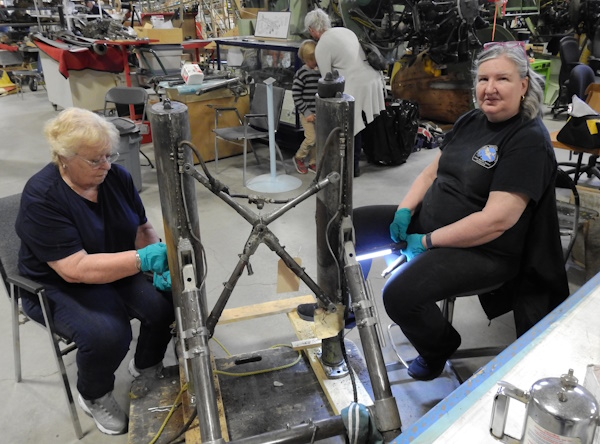
To the amazement of her husband David Coeshall (right), Jan sat down to help our Treasurer Colette, P., clean the second main undercarriage leg for the Mosquito during their visit from the UK in June. David 'confided' to me that for 50 years he'd been unsuccessful in sparking Jan's interest in his favourite aircraft type. Who knew that the opportunity to work on one would do the trick?

Richard de Boer, President
July 11, 2024
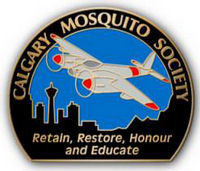
Website - Calgary Mosquito Aircraft Society








